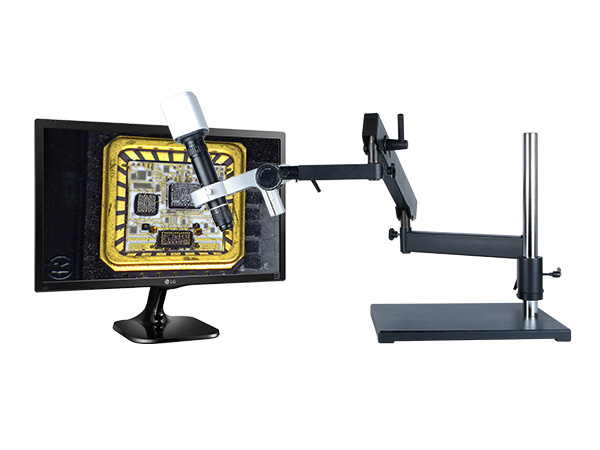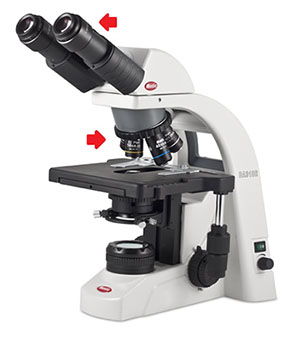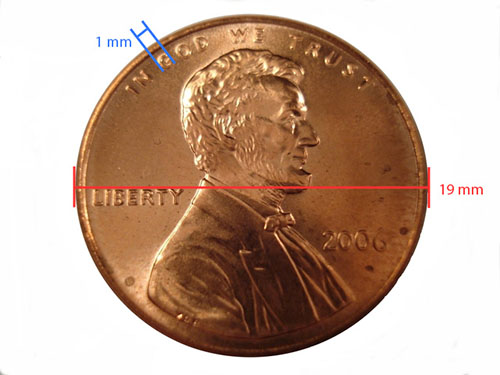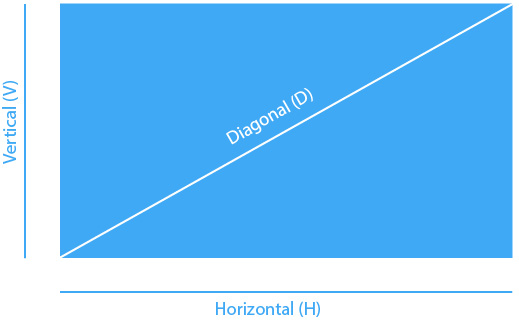
Microscopes are used to enlarge the image of your object or specimen, so you would assume magnification ranges should be used as specification requirement when shopping for a new microscope. However, determining magnification on a traditional microscope differs from the way it is calculated on a digital microscope, so it would be not be comparing apples to apples without some hand calculations. Instead, field of view should be used as the quantitative value to determine which digital microscopes will work best for your application.

Traditional Microscopes: Magnification through Eyepieces and Objective Lenses
Let’s first take a step back: how is magnification (referred to as optical magnification) calculated on traditional microscope with eyepieces? Your typical lab microscope has a pair of eyepieces and some objective lenses installed, both of which have a specified magnification power. Microscopes usually come standard with a pair of 10x eyepiece, but can be swapped out for higher magnification pairs. Objective lenses, which are installed in a turret design, can have magnifications of 4x, 10x, 20x, or higher.
Magnification on a traditional microscope is calculated by multiplying the eyepiece magnification with the objective magnification that the turret is set to. A microscope with 10x eyepieces and 20x objective lenses will have 200x magnification during inspection. Since magnification is marked on the eyepieces and objective lenses, it is the easiest way to determine what specs you need for your application, as the magnification is calculated in the same way across all traditional microscopes with eyepieces and objective lenses.
Digital Microscopes: Field of View on Monitor Screen
On a purely digital microscope, not only are there no eyepieces, there often will not be any objective lenses either to calculate optical magnification with. Instead, video magnification on a digital microscope is relative to the size of the monitor you are using with the microscope. For that reason, it is easier to refer to the field of view as the defining value to determine if a particular digital microscope model suits your application’s needs. The field of view (FOV) is the size of area that the digital microscope’s camera is seeing and displaying on the monitor screen. FOV, because it is a number representing a real dimension, can be easily determined just by knowing how big of an area you need to be inspecting.

For example, if you wanted to view a whole penny with a digital microscope, the penny has a diameter of 19mm, so you will need a minimum of 19mm field of view to see the entire penny on the monitor screen. If you wanted to focus on the letter “G” in the word “God” on the penny, then you will need at least 1mm field of view. Examining a 1mm feature in 19mm field of view, while doable, may not realistic for a close inspection of the details: 1mm would only take up 5% (1mm feature divided by 19mm FOV) of the monitor screen space. If the field of view was decreased to 4mm, then the 1mm feature would now fill up 25% of the monitor screen, allowing better viewing of the finer details on the “G”.
Since applications often require examining features in a variety of sizes, we often ask what your field of view range requirement is for your application. Continuing with the penny example, in order to examine both the letter “G” in detail and the penny in its entirety, it would be recommended to choose a digital microscope with at least 4mm to 19mm FOV range.
Reading a Viewing Chart: Why FOV over Magnification When Spec’-ing out a Digital Microscope?
Video magnification is usually not as clearly defined on a digital microscope as optical magnification are on a traditional microscope with eyepieces and objective lenses. While some digital microscopes’ software have a magnification read out feature, this is not as common of a feature as you’d think. If you really wanted to find out the magnification your digital microscope is currently at, you would need to know the FOV first before taking the additional step to calculate the magnification on the microscope in relation to the monitor size. Instead of converting these values into magnification just to compare apples to apples, why not skip this extra step when you can figure out what digital microscope you need with just the field of view values?
To demonstrate how that can be done, we will use our HD801 HD 1080p digital microscope’s viewing chart as a reference point. The HD801’s chart provides diagonal field of view values, which refers to the area of the size shown on screen, measured diagonally from one corner of the monitor to its opposite corner (D). FOV can be specified as diagonal, horizontal or vertical values.

The field of view, by definition, fills the entire monitor screen, and is not affected by the monitor size used. A digital microscope’s FOV range remains constant, but video magnification will change according to your monitor size. On the HD801, the smallest FOV that can be achieved is 0.2” at 4.5” working distance (2nd row on chart), regardless of monitor size. However, the smallest 0.2” FOV equates to a higher magnification when the digital microscope is connected to a 24” monitor (122x) than it would be if viewed on a 12” monitor (59x).
(Mobile: swipe left for horizontal scrolling)
| Working Distance | Field of View (Diagonal) | Video Mag. 12" Monitor | Video Mag. 24" Monitor | |||
| Low Mag. | High Mag. | Low Mag. | High Mag. | Low Mag. | High Mag. | |
| 4.5" (114 mm) | 1.2" | 0.2" | 9x | 59x | 20x | 122x |
| 30 mm | 5 mm | |||||
| 5" (127 mm) | 1.4" | 0.2" | 8x | 48x | 16x | 100x |
| 36 mm | 6.1 mm | |||||
| 6" (152 mm) | 1.9" | 0.3" | 6x | 36x | 13x | 75x |
| 47 mm | 8.1 mm | |||||
| 8" (203 mm) | 2.6" | 0.5" | 4x | 26x | 9x | 53x |
| 65 mm | 11.5 mm | |||||
| 10" (254 mm) | 3.3" | 0.6" | 3x | 20x | 7x | 41x |
| 85 mm | 15 mm | |||||
| 12" (305 mm) | 4.1" | 0.7" | 2x | 16x | 5x | 34x |
| 103 mm | 18 mm | |||||
Since the field of view remains a consistent, real dimension regardless of monitor size, we are able to use FOV to narrow down which digital microscope model may work best for your application requirements before we start finalizing the microscope configuration. Contact us today for assistance on finding the right digital microscope for our needs!
